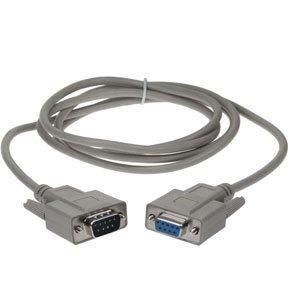Serial Cable Types
PC to UDS1100 or other DCE DB25: Use a standard 'straight-through' serial cable, often sold as a 'Modem Cable'. The Lantronix part number for this cable is 500-163-R:.Note: For decades a 9 pin D-subminiature connector has been referred to as a DB9. DB9 Female to DB25 Male Null Modem Serial Cable Add to Shopping List Add to Compare Use as Serial Printer Cable Fully Molded Thumbscrews Null Modem Pinout.
A serial cable is a cable used to transfer information between two devices using a serial communication protocol. The form of connectors depends on the particular serial port used. A cable wired for connecting two DTEs directly is known as a null modem cable.
Maximum cable lengths[edit]
The maximum working length of a cable varies depending on the characteristics of the transmitters and receivers, the baud rate on the cable, and the capacitance and electrical impedance of the cable. The RS-232 standard states that a compliant port must provide defined signal characteristics for a capacitive load of 2500 pF. This does not correspond to a fixed length of cable since varying cables have different characteristics. Empirically tested combinations of bit rate, serial ports, cable type, and lengths may provide reliable communications, but generally RS-232-compatible ports are intended to be connected by, at the most, a few tens of metres of cable. Other serial communications standards are better adapted to drive hundreds or thousands of metres of cable.

See also[edit]
| Wikibooks has a book on the topic of: Serial Programming:RS-232 Connections |
- LapLink cable (can be seen as a parallel equivalent to a serial null modem cable)
- Rollover cable (also known as a “Yost” cable.)
References[edit]
Even though there have been advances in wireless technologies, many computer networks in the 21st century rely on cables as the physical medium that devices use to transfer data. Several standard types of network cables exist, each designed for specific purposes.
Coaxial Cables
Invented in the 1880s, coaxial cable (also called coax) was best known as the kind of cable that connected television sets to home antennas. Coaxial cable is also a standard for 10 Mbps Ethernet cables.
When 10 Mbps Ethernet was most popular, during the 1980s and early 1990s, networks typically used one of two kinds of coax cable — thinnet (10BASE2 standard) or thicknet (10BASE5). These cables consist of an inner copper wire of varying thickness surrounded by insulation and another shielding. Their stiffness caused network administrators difficulty when installing and maintaining thinnet and thicknet.
Twisted Pair Cables
Twisted pair emerged during the 1990s as the leading cabling standard for Ethernet, starting with 10 Mbps (10BASE-T, also known as Category 3 or Cat3), later followed by improved versions for 100 Mbps (100BASE-TX, Cat5, and Cat5e) and successively higher speeds up to 10 Gbps (10GBASE-T). Ethernet twisted pair cables contain up to eight wires wound together in pairs to minimize electromagnetic interference.
Two primary types of twisted pair cable industry standards have been defined: unshielded twisted pair (UTP) and shielded twisted pair (STP). Modern Ethernet cables use UTP wiring due to its lower cost, while STP cabling can be found in other types of networks such as Fiber Distributed Data Interface (FDDI).
Fiber Optics
Instead of insulated metal wires transmitting electrical signals, fiber optic network cables use strands of glass and pulses of light. These network cables are bendable despite being made of glass. They have proven especially useful in wide area network (WAN) installations where long-distance underground or outdoor cable runs are required and also in office buildings where a high volume of communication traffic is common.

Two primary types of fiber optic cable industry standards are defined — single-mode (100BaseBX standard) and multimode (100BaseSX standard). Long-distance telecommunications networks commonly use single-mode for its relatively higher bandwidth capacity, while local networks typically use multimode due to its lower cost.
USB Cables
Most Universal Serial Bus (USB) cables connect a computer with a peripheral device (such as a keyboard or mouse) rather than to another computer. However, special network adapters (sometimes called dongles) connect an Ethernet cable to a USB port indirectly. USB cables feature twisted-pair wiring.
Everything You Need to Know About USB Ports and Cables
Serial and Parallel Cables
Because many PCs in the 1980s and early 1990s lacked Ethernet capability, and USB had not been developed yet, serial and parallel interfaces (now obsolete on modern computers) were sometimes used for PC-to-PC networking. So-called null model cables, for example, connected the serial ports of two PCs and enabled data transfers at speeds between 0.115 and 0.45 Mbps.
Crossover Cables
Null modem cables are one example of the category of crossover cables. A crossover cable joins two network devices of the same type, such as two PCs or two network switches. The use of Ethernet crossover cables was common on older home networks years ago when connecting two PCs directly together.
Serial Ata Cable Types
Externally, Ethernet crossover cables appear identical to ordinary cables (sometimes called straight-through), the only visible difference being the order of the color-coded wires appearing on the cable's end connector. Manufacturers typically applied special distinguishing marks to their crossover cables for this reason. Nowadays, though, most home networks utilize routers that have built-in crossover capability, eliminating the need for these special cables.
Other Types of Network Cables
Some networking professionals use the term patch cable to refer to any kind of straight-through network cable used for a temporary purpose. Coax, twisted pair, and fiber optic types of patch cables exist. These cables share the same physical characteristics as other types of network cables except that patch cables tend to be a shorter length.
Serial Cable Types Of Numbers
Powerline network systems utilize a home's standard electrical wiring for data communication using special adapters plugged into wall outlets.